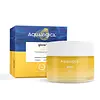What's inside
What's inside
 Key Ingredients
Key Ingredients

 Benefits
Benefits

 Concerns
Concerns

 Ingredients Side-by-side
Ingredients Side-by-side

Water
Skin ConditioningGlycerin
HumectantCaprylic/Capric Triglyceride
MaskingNiacinamide
SmoothingDimethicone
EmollientButylene Glycol
HumectantGlyceryl Stearate
EmollientPEG-100 Stearate
Xylitylglucoside
HumectantAnhydroxylitol
HumectantXylitol
HumectantHyaluronic Acid
HumectantGlyceryl Glucoside
HumectantButyrospermum Parkii Butter
Skin ConditioningCetyl Alcohol
EmollientZea Mays Starch
AbsorbentPanthenol
Skin ConditioningTocopheryl Acetate
AntioxidantPrunus Persica Kernel Oil
EmollientLaminaria Digitata Extract
Skin ProtectingCetyl-Pg Hydroxyethyl Palmitamide
Skin ConditioningCeramide EOP
Skin ConditioningCeramide Ns
Skin ConditioningCeramide NP
Skin ConditioningCeramide As
Skin ConditioningCeramide AP
Skin ConditioningHydrolyzed Milk Protein
Skin ConditioningFragaria Vesca Fruit Extract
AstringentAlpha-Arbutin
AntioxidantAcrylates/Beheneth-25 Methacrylate Copolymer
Ammonium Acryloyldimethyltaurate/Vp Copolymer
Titanium Dioxide
Cosmetic ColorantArginine
MaskingEthylhexylglycerin
Skin ConditioningPhenoxyethanol
PreservativeSodium Hydroxide
BufferingDisodium EDTA
CI 42090
Cosmetic ColorantCI 16035
Cosmetic ColorantWater, Glycerin, Caprylic/Capric Triglyceride, Niacinamide, Dimethicone, Butylene Glycol, Glyceryl Stearate, PEG-100 Stearate, Xylitylglucoside, Anhydroxylitol, Xylitol, Hyaluronic Acid, Glyceryl Glucoside, Butyrospermum Parkii Butter, Cetyl Alcohol, Zea Mays Starch, Panthenol, Tocopheryl Acetate, Prunus Persica Kernel Oil, Laminaria Digitata Extract, Cetyl-Pg Hydroxyethyl Palmitamide, Ceramide EOP, Ceramide Ns, Ceramide NP, Ceramide As, Ceramide AP, Hydrolyzed Milk Protein, Fragaria Vesca Fruit Extract, Alpha-Arbutin, Acrylates/Beheneth-25 Methacrylate Copolymer, Ammonium Acryloyldimethyltaurate/Vp Copolymer, Titanium Dioxide, Arginine, Ethylhexylglycerin, Phenoxyethanol, Sodium Hydroxide, Disodium EDTA, CI 42090, CI 16035
Water
Skin ConditioningCaprylic/Capric Triglyceride
MaskingCoco-Caprylate/Caprate
EmollientGlycerin
HumectantGlyceryl Glucoside
HumectantGlyceryl Stearate
EmollientCarica Papaya Fruit Extract
Skin ConditioningBetaine
HumectantLecithin
EmollientSodium Ascorbyl Phosphate
AntioxidantPentaerythrityl Distearate
EmulsifyingBehenyl Alcohol
EmollientSodium Hyaluronate Crosspolymer
HumectantPentylene Glycol
Skin ConditioningCarbomer
Emulsion StabilisingSodium Acrylates Copolymer
Trisodium Ethylenediamine Disuccinate
Iron Oxides
Ethylhexylglycerin
Skin ConditioningSodium Hydroxide
BufferingPhenoxyethanol
PreservativeParfum
MaskingWater, Caprylic/Capric Triglyceride, Coco-Caprylate/Caprate, Glycerin, Glyceryl Glucoside, Glyceryl Stearate, Carica Papaya Fruit Extract, Betaine, Lecithin, Sodium Ascorbyl Phosphate, Pentaerythrityl Distearate, Behenyl Alcohol, Sodium Hyaluronate Crosspolymer, Pentylene Glycol, Carbomer, Sodium Acrylates Copolymer, Trisodium Ethylenediamine Disuccinate, Iron Oxides, Ethylhexylglycerin, Sodium Hydroxide, Phenoxyethanol, Parfum
Ingredients Explained
These ingredients are found in both products.
Ingredients higher up in an ingredient list are typically present in a larger amount.
This ingredient is an emollient, solvent, and texture enhancer. It is considered a skin-softener by helping the skin prevent moisture loss.
It helps thicken a product's formula and makes it easier to spread by dissolving clumping compounds.
Caprylic Triglyceride is made by combining glycerin with coconut oil, forming a clear liquid.
While there is an assumption Caprylic Triglyceride can clog pores due to it being derived from coconut oil, there is no research supporting this.
Learn more about Caprylic/Capric TriglycerideEthylhexylglycerin (we can't pronounce this either) is commonly used as a preservative and skin softener. It is derived from glyceryl.
You might see Ethylhexylglycerin often paired with other preservatives such as phenoxyethanol. Ethylhexylglycerin has been found to increase the effectiveness of these other preservatives.
Glycerin is already naturally found in your skin. It helps moisturize and protect your skin.
A study from 2016 found glycerin to be more effective as a humectant than AHAs and hyaluronic acid.
As a humectant, it helps the skin stay hydrated by pulling moisture to your skin. The low molecular weight of glycerin allows it to pull moisture into the deeper layers of your skin.
Hydrated skin improves your skin barrier; Your skin barrier helps protect against irritants and bacteria.
Glycerin has also been found to have antimicrobial and antiviral properties. Due to these properties, glycerin is often used in wound and burn treatments.
In cosmetics, glycerin is usually derived from plants such as soybean or palm. However, it can also be sourced from animals, such as tallow or animal fat.
This ingredient is organic, colorless, odorless, and non-toxic.
Glycerin is the name for this ingredient in American English. British English uses Glycerol/Glycerine.
Learn more about GlycerinGlyceryl Glucoside is made from glycerol and glucose.
It is a humectant. Humectants help hydrate your skin by drawing moisture to it from the air.
Some foods that contain glyceryl glucoside include sake, miso, and wines.
Learn more about Glyceryl GlucosideGlyceryl Stearate is a mix of glycerin and stearic acid.
It is used to stabilize the mixing of water and oil ingredients. By preventing these ingredients from separating, it can help elongate shelf life. It can also help thicken the product's texture.
As an emollient, it helps soften skin and supports barrier-replenishing ingredients.
In cosmetics, Glyceryl Stearate is often made from vegetable oils or synthetically produced.
This ingredient may not be fungal-acne safe
Fun fact: The human body also creates Glyceryl Stearate naturally.
Learn more about Glyceryl StearatePhenoxyethanol is a preservative that has germicide, antimicrobial, and aromatic properties. Studies show that phenoxyethanol can prevent microbial growth. By itself, it has a scent that is similar to that of a rose.
It's often used in formulations along with Caprylyl Glycol to preserve the shelf life of products.
Sodium Hydroxide is also known as lye or caustic soda. It is used to adjust the pH of products; many ingredients require a specific pH to be effective.
In small amounts, sodium hydroxide is considered safe to use. However, large amounts may cause chemical burns due to its high alkaline.
Your skin has a natural pH and acid mantle. This acid mantle helps prevent harmful bacteria from breaking through. The acid mantle also helps keep your skin hydrated.
"Alkaline" refers to a high pH level. A low pH level would be considered acidic.
Learn more about Sodium HydroxideWater. It's the most common cosmetic ingredient of all. You'll usually see it at the top of ingredient lists, meaning that it makes up the largest part of the product.
So why is it so popular? Water most often acts as a solvent - this means that it helps dissolve other ingredients into the formulation.
You'll also recognize water as that liquid we all need to stay alive. If you see this, drink a glass of water. Stay hydrated!
Learn more about Water